sensor CHEVROLET CAMARO 1967 1.G Chassis Workshop Manual
[x] Cancel search | Manufacturer: CHEVROLET, Model Year: 1967, Model line: CAMARO, Model: CHEVROLET CAMARO 1967 1.GPages: 659, PDF Size: 114.24 MB
Page 41 of 659
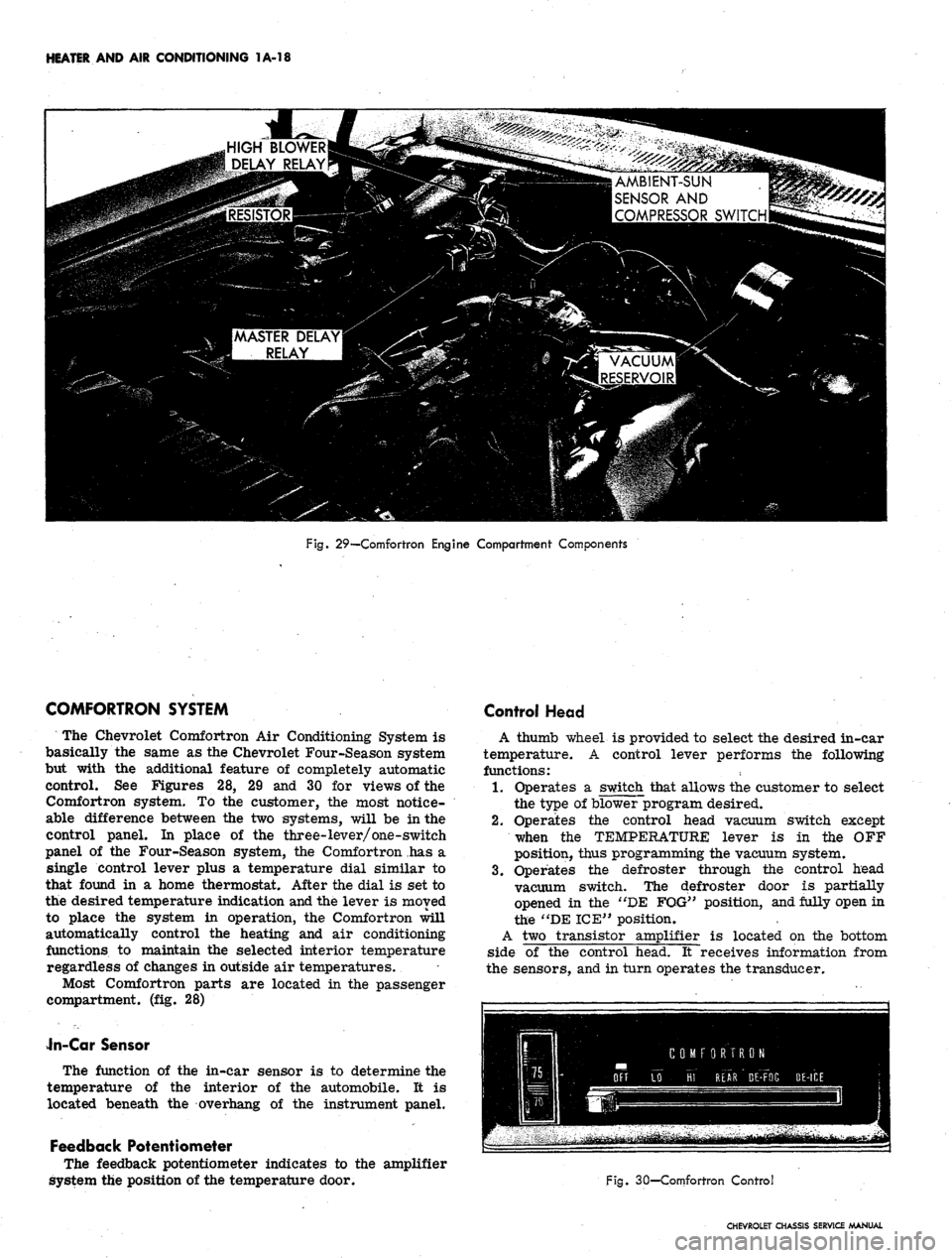
HEATER AND AIR CONDITIONING 1A-18
HIGH BLOWER
i DELAY RELAY
AMBIENT-SUN
SENSOR AND
COMPRESSOR SWITCH
Fig. 29—Comfortron Engine Compartment Components
COMFORTRON SYSTEM
The Chevrolet Comfortron Air Conditioning System is
basically the same as the Chevrolet Four-Season system
but with the additional feature of completely automatic
control. See Figures 28, 29 and 30 for views of the
Comfortron system. To the customer, the most notice-
able difference between the two systems, will be in the
control panel. In place of the three-lever/one-switch
panel of the Four-Season system, the Comfortron has a
single control lever plus a temperature dial similar to
that found in a home thermostat. After the dial is set to
the desired temperature indication and the lever is moved
to place the system in operation, the Comfortron will
automatically control the heating and air conditioning
functions to maintain the selected interior temperature
regardless of changes in outside air temperatures.
Most Comfortron parts are located in the passenger
compartment, (fig. 28)
Jn-Car Sensor
The function of the in-car sensor is to determine the
temperature of the interior of the automobile. It is
located beneath the overhang of the instrument panel.
Feedback Potentiometer
The feedback potentiometer indicates to the amplifier
system the position of the temperature door.
Control Head
A thumb wheel is provided to select the desired in-car
temperature. A control lever performs the following
functions:
1.
Operates a switch that allows the customer to select
the type of blower program desired.
2.
Operates the control head vacuum switch except
when the TEMPERATURE lever is in the OFF
position, thus programming the vacuum system.
3.
Operates the defroster through the control head
vacuum switch. The defroster door is partially
opened in the "DE FOG" position, and fully open in
the "DE ICE" position.
A two transistor amplifier is located on the bottom
side of the control head. It receives information from
the sensors, and in turn operates the transducer.
Fig. 30—Comfortron Control
CHEVROLET CHASSIS SERVICE MANUAL
Page 42 of 659
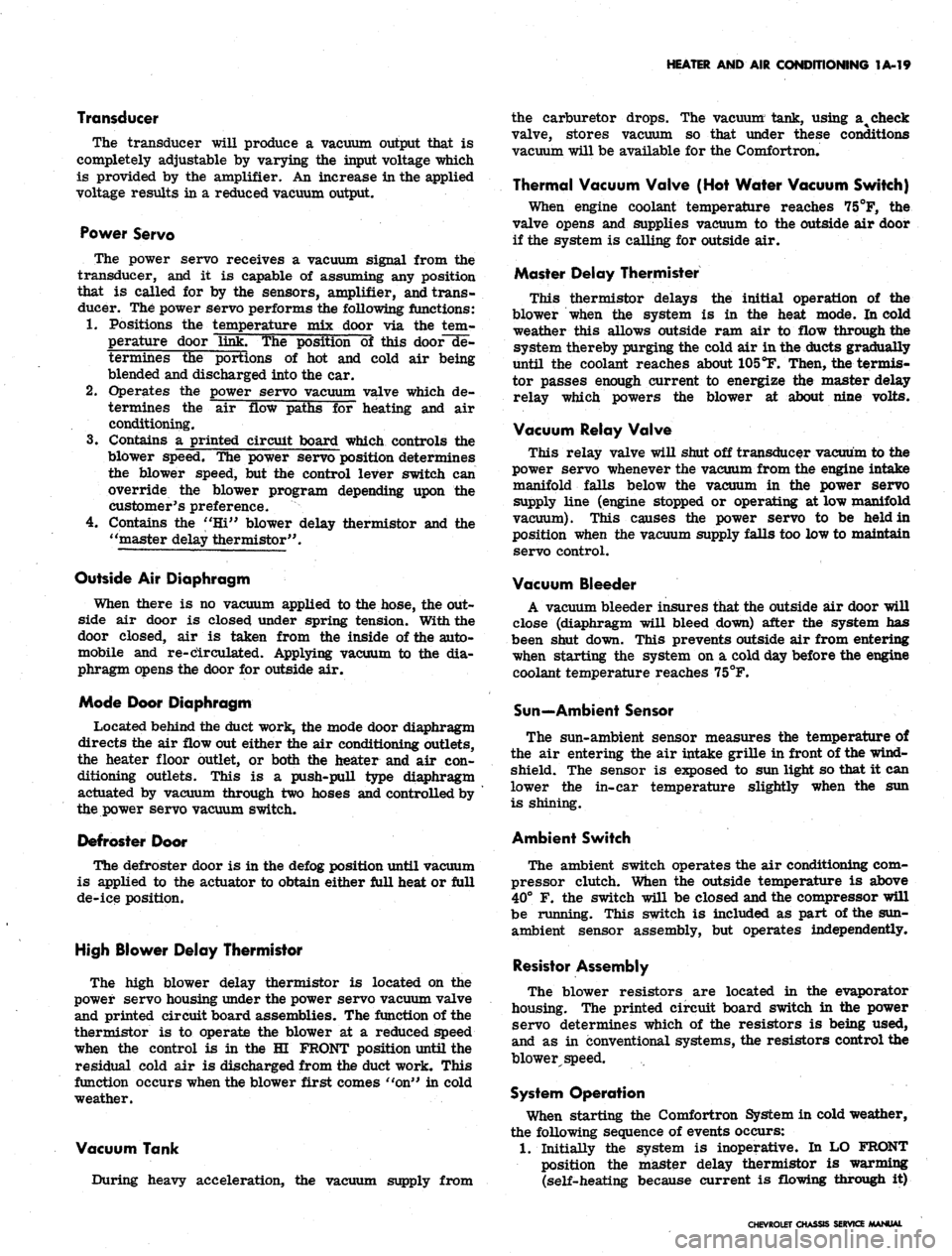
HEATER AND AIR CONDITIONING 1A-19
Transducer
The transducer will produce a vacuum output that is
completely adjustable by varying the input voltage which
is provided by the amplifier. An increase in the applied
voltage results in a reduced vacuum output.
Power Servo
The power servo receives a vacuum signal from the
transducer, and it is capable of assuming any position
that is called for by the sensors, amplifier, and trans-
ducer. The power servo performs the following functions:
1.
Positions the temperature mix door via the tern-
perature door link. The position of this door~"de-
termihes the portions of hot and cold air being
blended and discharged into the car.
2.
Operates the power servo vacuum valve which de-
termines the air flow paths for heating and air
conditioning.
3.
Contains a printed circuit board which controls the
blower speed. The power servo position determines
the blower speed, but the control lever switch can
override the blower program depending upon the
customer's preference.
4.
Contains the "Hi" blower delay thermistor and the
"master delay thermistor".
Outside Air Diaphragm
When there is no vacuum applied to the hose, the out-
side air door is closed under spring tension. With the
door closed, air is taken from the inside of the auto-
mobile and re-circulated. Applying vacuum to the dia-
phragm opens the door for outside air.
Mode Door Diaphragm
Located behind the duct work, the mode door diaphragm
directs the air flow out either the air conditioning outlets,
the heater floor outlet, or both the heater and air con-
ditioning outlets. This is a push-pull type diaphragm
actuated by vacuum through two hoses and controlled by
the power servo vacuum switch.
Defroster Door
The defroster door is in the defog position until vacuum
is applied to the actuator to obtain either full heat or full
de-ice position.
High Blower Delay Thermistor
The high blower delay thermistor is located on the
power servo housing under the power servo vacuum valve
and printed circuit board assemblies. The function of the
thermistor is to operate the blower at a reduced speed
when the control is in the HI FRONT position until the
residual cold air is discharged from the duct work. This
function occurs when the blower first comes "on" in cold
weather.
Vacuum Tank
During heavy acceleration, the vacuum supply from
the carburetor drops. The vacuum tank, using a^ check
valve, stores vacuum so that under these conditions
vacuum will be available for the Comfortron.
Thermal Vacuum Valve (Hot Water Vacuum Switch)
When engine coolant temperature reaches 75°F, the
valve opens and supplies vacuum to the outside air door
if the system is calling for outside air.
Master Delay Thermister
This thermistor delays the initial operation of the
blower when the system is in the heat mode. In cold
weather this allows outside ram air to flow through the
system thereby purging the cold air in the ducts gradually
until the coolant reaches about 105°F. Then, the termis-
tor passes enough current to energize the master delay
relay which powers the blower at about nine volts.
Vacuum Relay Valve
This relay valve will shut off transducer vacuum to the
power servo whenever the vacuum from the engine intake
manifold falls below the vacuum in the power servo
supply line (engine stopped or operating at low manifold
vacuum). This causes the power servo to be held in
position when the vacuum supply falls too low to maintain
servo control.
Vacuum Bleeder
A vacuum bleeder insures that the outside air door will
close (diaphragm will bleed down) after the system has
been shut down. This prevents outside air from entering
when starting the system on a cold day before the engine
coolant temperature reaches 75°F.
Sun—Ambient Sensor
The sun-ambient sensor measures the temperature of
the air entering the air intake grille in front of the wind-
shield. The sensor is exposed to sun light so that it can
lower the in-car temperature slightly when the sun
is shining.
Ambient Switch
The ambient switch operates the air conditioning com-
pressor clutch. When the outside temperature is above
40° F. the switch will be closed and the compressor will
be running. This switch is included as| part of the sun-
ambient sensor assembly, but operates independently.
Resistor Assembly
The blower resistors are located in the evaporator
housing. The printed circuit board switch in the power
servo determines which of the resistors is being used,
and as in conventional systems, the resistors control the
blower speed.
System Operation
When starting the Comfortron System in cold weather,
the following sequence of events occurs:
1.
Initially the system is inoperative. In LO FRONT
position the master delay thermistor is warming
(self-heating because current is flowing through it)
CHEVROLET CHASSIS SERVICE MANUAL
Page 43 of 659
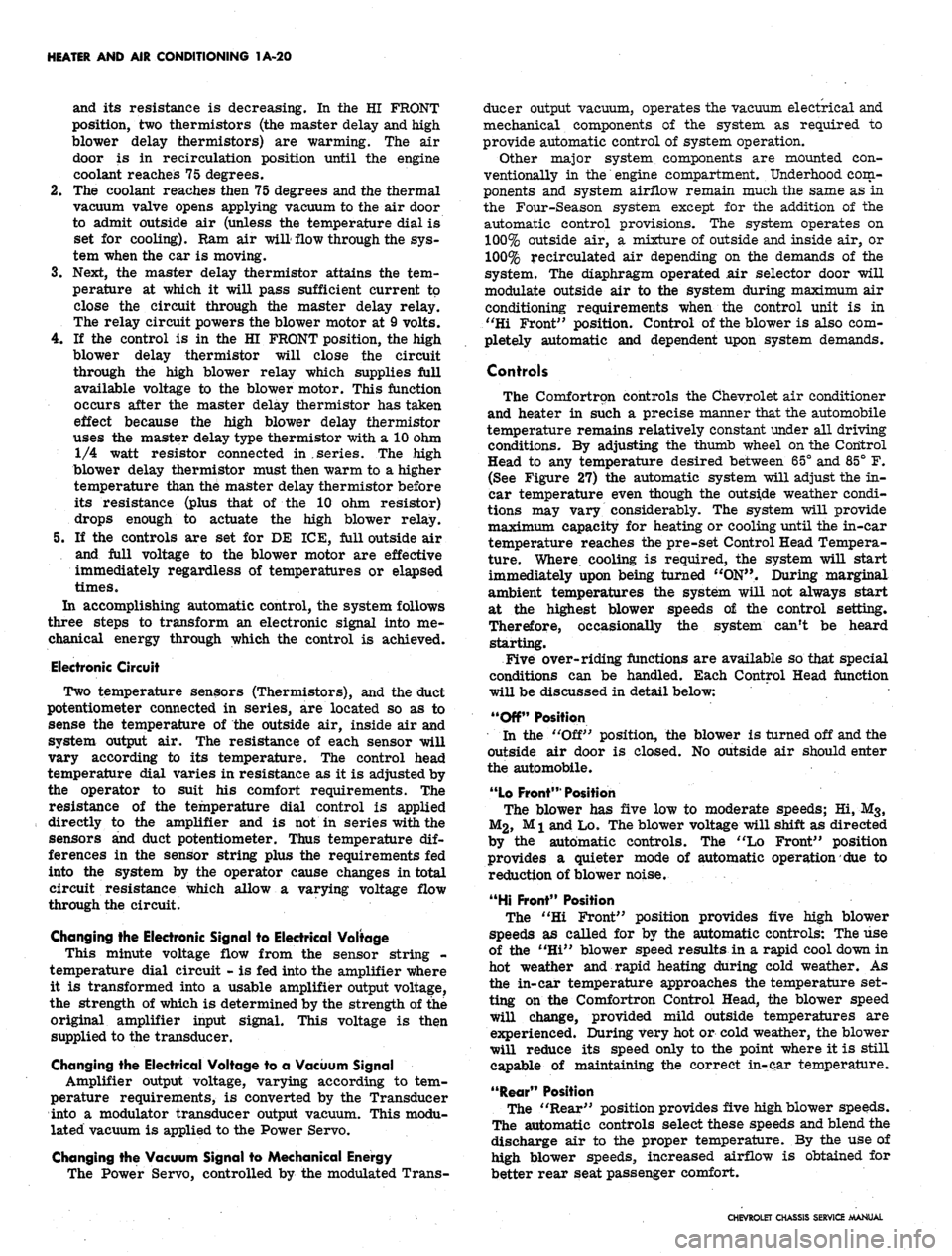
HEATER AND AIR CONDITIONING 1A-20
and its resistance is decreasing. In the HI FRONT
position, two thermistors (the master delay and high
blower delay thermistors) are warming. The air
door is in recirculation position until the engine
coolant reaches 75 degrees.
2.
The coolant reaches then 75 degrees and the thermal
vacuum valve opens applying vacuum to the air door
to admit outside air (unless the temperature dial is
set for cooling). Ram air will flow through the sys-
tem when the car is moving.
3.
Next, the master delay thermistor attains the tem-
perature at which it will pass sufficient current to
close the circuit through the master delay relay.
The relay circuit powers the blower motor at 9 volts.
4.
If the control is in the HI FRONT position, the high
blower delay thermistor will close the circuit
through the high blower relay which supplies full
available voltage to the blower motor. This function
occurs after the master delay thermistor has taken
effect because the high blower delay thermistor
uses the master delay type thermistor with a 10 ohm
1/4 watt resistor connected in
.
series. The nigh
blower delay thermistor must then warm to a higher
temperature than the master delay thermistor before
its resistance (plus that of the 10 ohm resistor)
drops enough to actuate the high blower relay.
5. If the controls are set for DE ICE, full outside air
and full voltage to the blower motor are effective
immediately regardless of temperatures or elapsed
times o
In accomplishing automatic control, the system follows
three steps to transform an electronic signal into me-
chanical energy through which the control is achieved.
Electronic Circuit
Two temperature sensors (Thermistors), and the duct
potentiometer connected in series, are located so as to
sense the temperature of the outside air, inside air and
system output air. The resistance of each sensor will
vary according to its temperature. The control head
temperature dial varies in resistance as it is adjusted by
the operator to suit his comfort requirements. The
resistance of the temperature dial control is applied
directly to the amplifier and is not in series with the
sensors and duct potentiometer. Thus temperature dif-
ferences in the sensor string plus the requirements fed
into the system by the operator cause changes in total
circuit resistance which allow a varying voltage flow
through the circuit.
Changing the Electronic Signal to Electrical Voltage
This minute voltage flow from the sensor string -
temperature dial circuit - is fed into the amplifier where
it is transformed into a usable amplifier output voltage,
the strength of which is determined by the strength of the
original amplifier input signal. This voltage is then
supplied to the transducer.
Changing the Electrical Voltage to a Vacuum Signal
Amplifier output voltage, varying according to tem-
perature requirements, is converted by the Transducer
into a modulator transducer output vacuum. This modu-
lated vacuum is applied to the Power Servo.
Changing the Vacuum Signal to Mechanical Energy
The Power Servo, controlled by the modulated Trans-
ducer output vacuum, operates the vacuum electrical and
mechanical components of the system as required to
provide automatic control of system operation.
Other major system components are mounted con-
ventionally in the engine compartment. Underhood com-
ponents and system airflow remain much the same as in
the Four-Season system except for the addition of the
automatic control provisions. The system operates on
100%
outside air, a mixture of outside and inside air, or
100%
recirculated air depending on the demands of the
system. The diaphragm operated .air selector door will
modulate outside air to the system during maximum air
conditioning requirements when the control unit is in
"Hi Front" position. Control of the blower is also com-
pletely automatic and dependent upon system demands.
Controls
The Comfortron controls the Chevrolet air conditioner
and heater in such a precise manner that the automobile
temperature remains relatively constant under all driving
conditions. By adjusting the thumb wheel on the Control
Head to any temperature desired between 65° and 85° F.
(See Figure 27) the automatic system will adjust the in-
car temperature even though the outside weather condi-
tions may vary considerably. The system will provide
maximum capacity for heating or cooling until the in-car
temperature reaches the pre-set Control Head Tempera-
ture. Where cooling is required, the system will start
immediately upon being turned "ON". During marginal
ambient temperatures the system will not always start
at the highest blower speeds of the control setting.
Therefore, occasionally the system can't be heard
starting*
Five over-riding functions are available so that special
conditions can be handled. Each Control Head function
will be discussed in detail below:
"Off" Position
In the "Off" position, the blower is turned off and the
outside air door is closed. No outside air should enter
the automobile.
"Lo Front" Position
The blower has five low to moderate speeds; Hi, M3,
M2,
M1 and Lo. The blower voltage will shift as directed
by the automatic controls. The "Lo Front" position
provides a quieter mode of automatic operation due to
reduction of blower noise.
"Hi Front" Position
The "Hi Front" position provides five high blower
speeds as called for by the automatic controls: The use
of the "Hi" blower speed results in a rapid cool down in
hot weather and rapid heating during cold weather. As
the in-car temperature approaches the temperature set-
ting on the Comfortron Control Head, the blower speed
will change, provided mild outside temperatures are
experienced. During very hot or cold weather, the blower
will reduce its speed only to the point where it is still
capable of maintaining the correct inrcar temperature.
"Rear" Position
The "Rear" position provides five high blower speeds.
The automatic controls select these speeds and blend the
discharge air to the proper temperature. By the use of
high blower speeds, increased airflow is obtained for
better rear seat passenger comfort.
CHEVROLET CHASSIS SERVICE MANUAL
Page 57 of 659
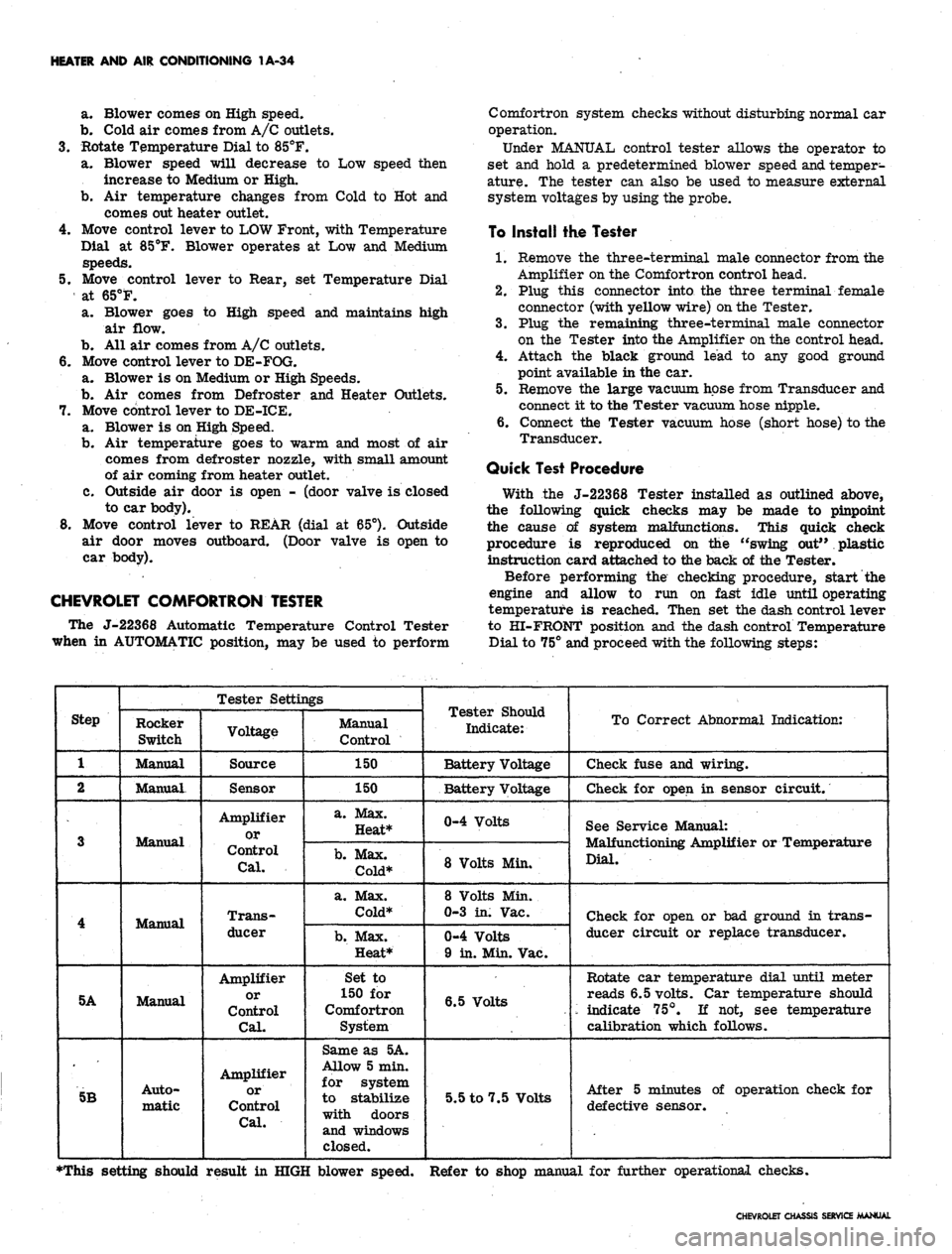
HEATER AND AIR CONDITIONING 1A-34
a. Blower comes on High speed.
b.
Cold air comes from A/C outlets.
3.
Rotate Temperature Dial to 85°F.
a. Blower speed will decrease to Low speed then
increase to Medium or High.
b.
Air temperature changes from Cold to Hot and
comes out heater outlet.
4.
Move control lever to LOW Front, with Temperature
Dial at 85°F. Blower operates at Low and Medium
speeds.
5.
Move control lever to Rear, set Temperature Dial
at 65°F.
a. Blower goes to High speed and maintains high
air flow.
b.
All air comes from A/C outlets.
6. Move control lever to DE-FOG.
a. Blower is on Medium or High Speeds.
b.
Air comes from Defroster and Heater Outlets.
7.
Move control lever to DE-ICE.
a. Blower is on High Speed.
b.
Air temperature goes to warm and most of air
comes from defroster nozzle, with small amount
of air coming from heater outlet.
c. Outside air door is open - (door valve is closed
to car body).
8. Move control lever to REAR (dial at 65°). Outside
air door moves outboard. (Door valve is open to
car body).
CHEVROLET COMFORTRON TESTER
The J-22368 Automatic Temperature Control Tester
when in AUTOMATIC position, may be used to perform
Comfortron system checks without disturbing normal car
operation.
Under MANUAL control tester allows the operator to
set and hold a predetermined blower speed
and.
temper-
ature. The tester can also be used to measure external
system voltages by using the probe.
To Install the Tester
1.
Remove the three-terminal male connector from the
Amplifier on the Comfortron control head.
2.
Plug this connector into the three terminal female
connector (with yellow wire)
on
the Tester.
3.
Plug the remaining three-terminal male connector
on the Tester into the Amplifier on the control head.
4.
Attach the black ground lead to any good ground
point available in the car.
5.
Remove the large vacuum hose from Transducer and
connect it to the Tester vacuum hose nipple.
6. Connect the Tester vacuum hose (short hose) to the
Transducer.
Quick Test Procedure
With the J-22368 Tester installed as outlined above,
the following quick checks may be made to pinpoint
the cause of system malfunctions. This quick check
procedure is reproduced on the "swing out" plastic
instruction card attached to the back of the Tester.
Before performing the checking procedure, start the
engine and allow to run on fast idle until operating
temperature is reached. Then set the dash control lever
to HI-FRONT position and the dash control Temperature
Dial to 75° and proceed with the following steps:
Step
1
2
3
4
5A
5B
Tester Settings
Rocker
Switch
Manual
Manual.
Manual
Manual
Manual
Auto-
matic
Voltage
Source
Sensor
Amplifier
or
Control
Cal.
Trans-
ducer
Amplifier
or
Control
Cal.
Amplifier
or
Control
Cal.
Manual
Control
150
150
a. Max.
Heat*
b.
Max.
Cold*
a. Max.
Cold*
b.
Max.
Heat*
Set to
150 for
Comfortron
System
Same as 5A.
Allow 5 min.
for system
to stabilize
with doors
and windows
closed.
Tester Should
Indicate:
Battery Voltage
Battery Voltage
0-4 Volts
8 Volts Min.
8 Volts Min.
0-3 in. Vac.
0-4 Volts
9 in. Min. Vac.
6.5 Volts
5.5 to 7.5 Volts
To Correct Abnormal Indication:
Check fuse and wiring.
Check for open in sensor circuit.
See Service Manual:
Malfunctioning Amplifier or Temperature
Dial.
Check for open or bad ground in trans-
ducer circuit or replace transducer.
Rotate car temperature dial until meter
reads 6.5 volts. Car temperature should
'•- indicate 75°. If not, see temperature
calibration which follows.
After 5 minutes of operation check for
defective sensor.
•This setting should result in HIGH blower speed. Refer to shop manual for further operational checks.
CHEVROLET CHASSIS SERVICE MANUAL
Page 58 of 659
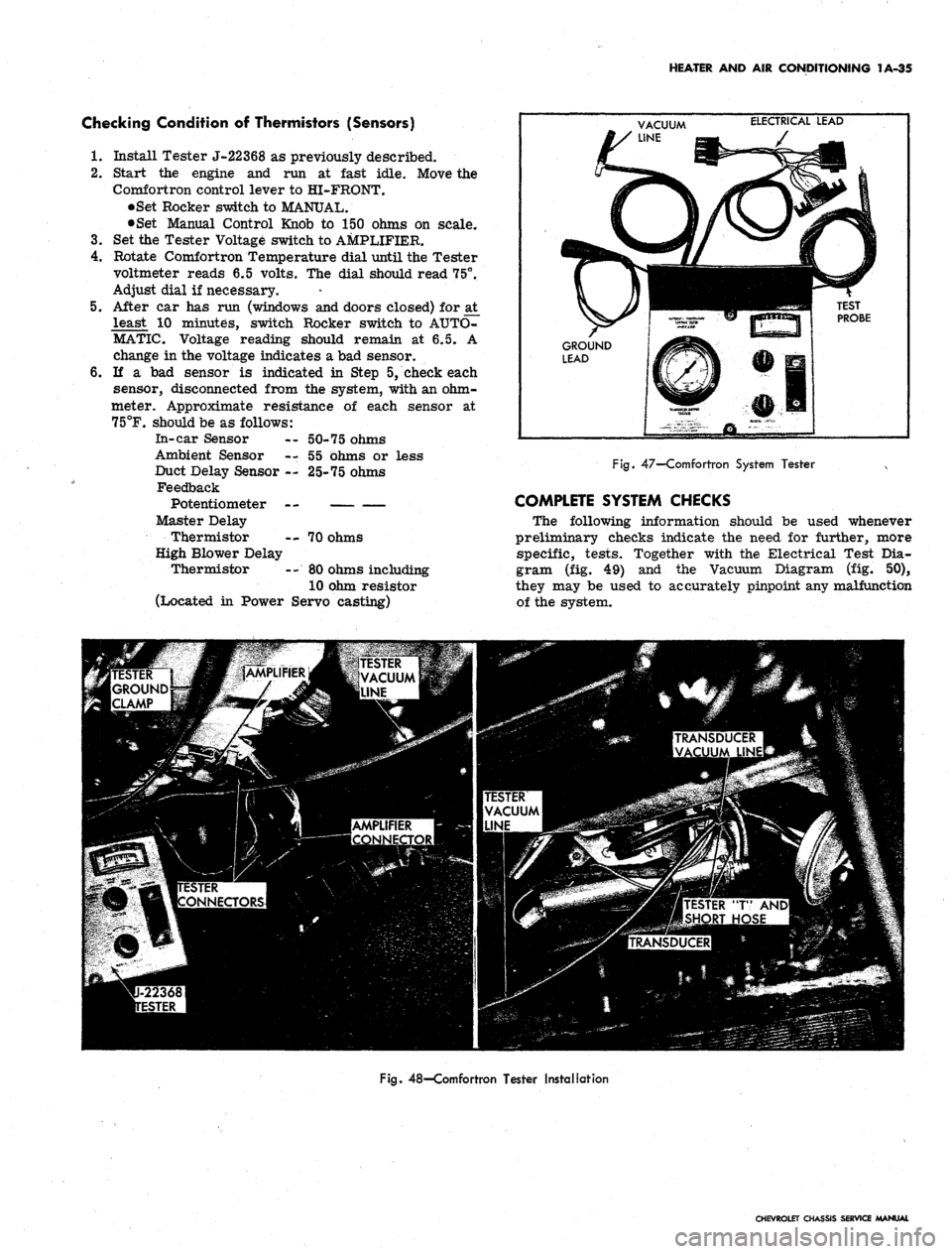
HEATER AND AIR CONDITIONING 1A-35
Checking Condition of Thermistors (Sensors)
1.
Install Tester J-22368 as previously described.
2.
Start the engine and run at fast idle. Move the
Comfortron control lever to HI-FRONT.
•Set Rocker switch to MANUAL.
•Set Manual Control Knob to 150 ohms on scale.
3.
Set the Tester Voltage switch to AMPLIFIER.
4.
Rotate Comfortron Temperature dial until the Tester
voltmeter reads 6.5 volts. The dial should read 75°,
Adjust dial if necessary.
5.
After car has run (windows and doors closed) for at
least 10 minutes, switch Rocker switch to AUTO-
MATIC. Voltage reading should remain at 6.5. A
change in the voltage indicates a bad sensor.
6. If a bad sensor is indicated in Step 5, check each
sensor, disconnected from the system, with an ohm-
meter. Approximate resistance of each sensor at
75°F.
should be as follows:
In-car Sensor — 50-75 ohms
Ambient Sensor --,55 ohms or less
Duct Delay Sensor -.- 25-75 ohms
Feedback
Potentiometer —
Master Delay
Thermistor -- 70 ohms
High Blower Delay
Thermistor -- 80 ohms including
10 ohm resistor
(Located in Power Servo casting)
VACUUM
ELECTRICAL LEAD
GROUND
LEAD
Fig.
47—Comfortron System Tester x
COMPLETE SYSTEM CHECKS
The following information should be used whenever
preliminary checks indicate the need for further, more
specific, tests. Together with the Electrical Test Dia-
gram (fig. 49) and the Vacuum Diagram (fig. 50),
they may be used to accurately pinpoint any malfunction
of the system.
Fig.
48—Comfortron Tester Installation
CHEVROLET OU
SERVICE MANUAL
Page 59 of 659
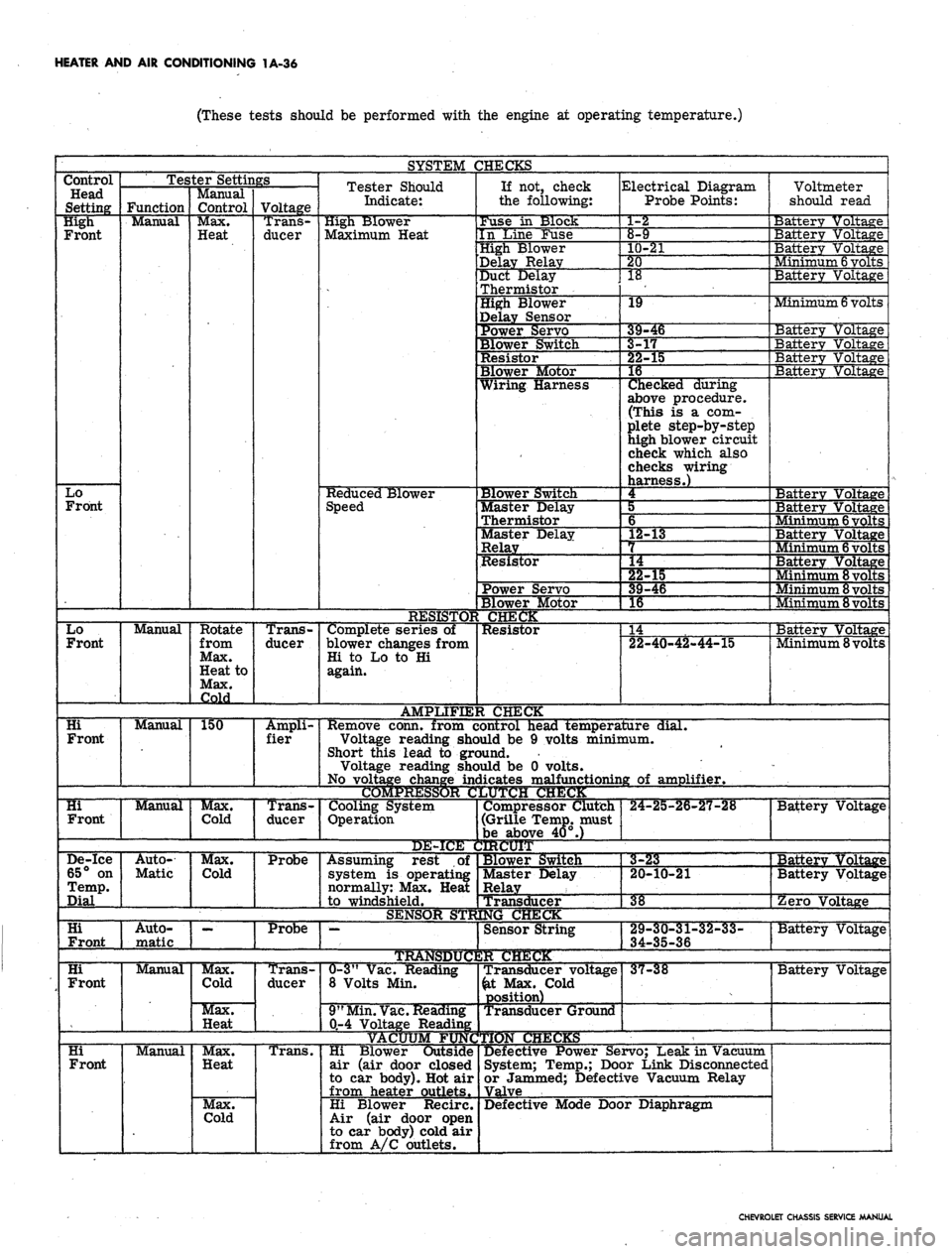
HEATER AND AIR CONDITIONING 1A-36
(These tests should be performed with the engine at operating temperature.)
SYSTEM CHECKS
Control
Head
Setting
High
Front
Lo
Front
Lo
Front
Hi
Front
Hi
Front
Tester Settings
Function
Manual
Manual
Manual
Manual
De-ice
65° on
Temp.
Dial
Hi
Front
Hi
Front
Hi
Front
Auto-
Matic
1 1
Auto-
matic
Manual
Manual
Manual
Control
Max.
Heat
Rotate
from
Max.
Heat to
Max.
Cold
150
Max.
Cold
Max.
Cold
Max.
Cold
Max.
Heat
Max.
Heat
Max.
Cold
Voltage
Trans-
ducer
Trans-
ducer
Ampli-
fier
Trans-
ducer
Probe
Probe
Trans-
ducer
Trans.
Tester Should
Indicate:
High Blower
Maximum Heat
Reduced Blower
Speed
Complete series of
blower changes from
Hi to Lo to Hi
again.
AMPLIFIE:
Remove conn, from c
Voltage reading she
Short this lead to grc
Voltage reading she
No voltage change in<
COMPRESSOR C
Cooling System
Operation
DE-ICE i
Assuming rest of
system is operating
normally: Max. Heat
1
to windshield.
SENSOR STR
•—
TRAtfSDtfC
0-3"
Vac. Reading
8 Volts Min.
9"
Min.
Vac.
Reading
0-4 Voltage Reading
If not, check
the following:
Fuse in Slock
In Line Fuse
High Blower
Delay Relay
Duct Delay
Thermistor
High Blower
Delay Sensor
Power Servo
Blower Switch
Resistor
Blower Motor
Wiring Harness
Blower Switch
Master Delay
Thermistor
Master Delay
Relay
Resistor
Power Servo
Blower Motor
CHECK
Resistor
I CHECK
Electrical Diagram
Probe Points:
1-2
8-9
10-21
20
18
19
*
9-46
-r
^2-3
15
16
Checked during
above procedure.
(This is a com-
plete step-by-step
high blower circuit
check which also
checks wiring
harness.)
4
5
6
L2-13
L4
""§2-15
39-46
1
16 1
14
22-40-42-44-15
.ontrol head temperature dial.
>uld be 9 volts minimum,
jund.
>uld be 0 volts,
iicates malfunctioning of amplifier.
JUTCJH CHUCK
Compressor Clutch
(Grille Temp, must
be above 40°.)
IRCUIT
Blower Switch
Master Delay
Relay
Transd
NGCl
ucer
Sensor String
2R CHECK
Transducer voltage
&t Max. Cold
position)
Transducer Ground
Hi Blower Outside
air (air door closed
to car body). Hot air
from heater outlets.
Hi Blower Recirc.
Air (air door open
to car body) cold air
from A/C outlets.
24-25-26-27-28
Voltmete
should re
ad
Battery Voltage
Battery Voltage
Battery Voltage
. Vtinimum
6
volts
Battery Voltage
Minimum
6
volts
Battery Vo]
Batterv Vo]
Ltage
Ltage
Battery Voltage
Batterv Voltage
3a
Bai
:terv Vo
tterv Vo
tage
tage
Minimum
6
volts
Batterv Voltage
Minimum
6
volts
Battery Voltage
Minimum
8
volts
Minimum 8 volts
Minimum 8 volts
Batterv Voltage
Minimum 8 volts
1 III • II »ll. —..• —•— . !!•• 1
Battery Voltage
3-23
20-10-21
38
29-30-31-32-33-
34-35-36
37-38
Defective Power Servo; Leak in Vacuum
System; Temp.; Door Link Disconnected
or Jammed; Defective Vacuum Relay
Valve
Defective Mode Door Diaphragm
Batterv Voltage
Battery Voltage
Zero Voltage
Battery Voltage
Battery Voltage
CHEVROLET CHASSIS SERVICE MANUAL
Page 62 of 659
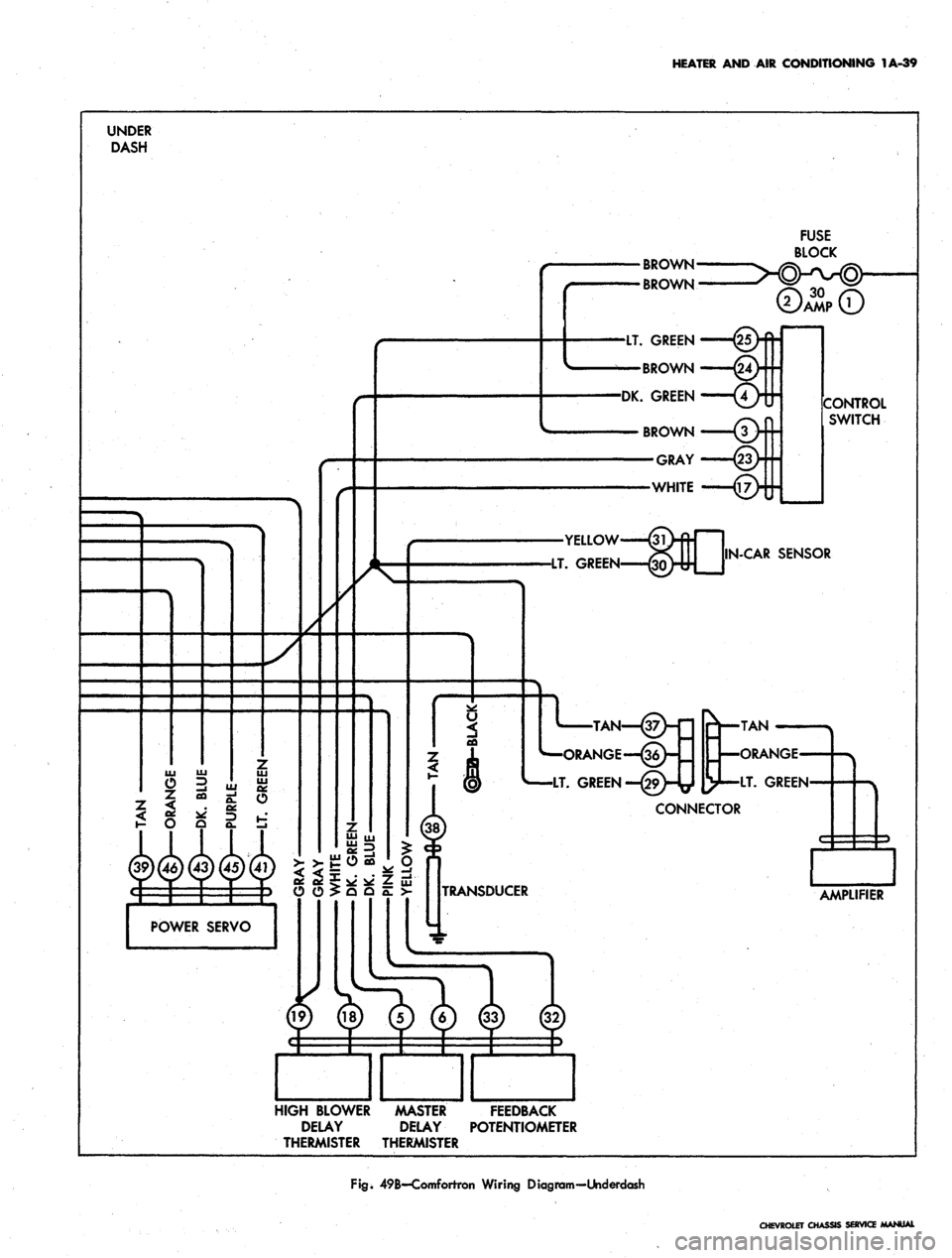
HEATER AND AIR CONDITIONING 1A-39
BROWN
BROWN
LT.
GREEN
BROWN
DK. GREEN
CONTROL
SWITCH
N-CAR
SENSOR
"—ORANGE—(36
[y—LT. GREEN
*)WWWW 55|—jg
TRANSDUCER
POWER SERVO
HIGH BLOWER MASTER FEEDBACK
DELAY DELAY POTENTIOMETER
THERMISTER THERMISTER
Fig.
49B-Comforrron Wiring Diagram-Underdash
CHEVROLET CHASSIS SERVICE AAANUAL
Page 91 of 659
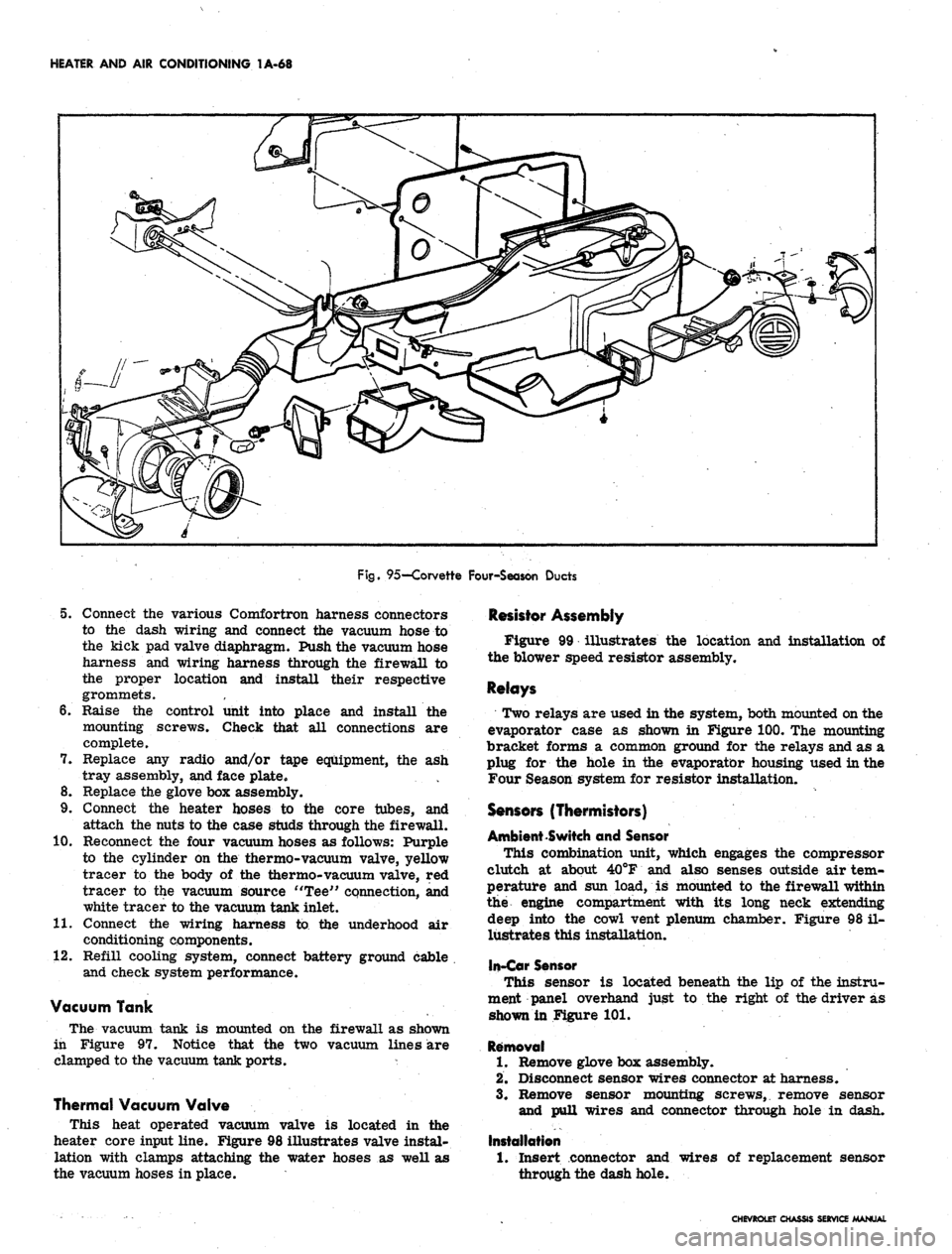
HEATER AND AIR CONDITIONING 1A-68
Fig.
95—Corvette Four-Season Ducts
5. Connect the various Comfortron harness connectors
to the dash wiring and connect the vacuum hose to
the kick pad valve diaphragm. Push the vacuum hose
harness and wiring harness through the firewall to
the proper location and install their respective
grommets.
6. Raise the control unit into place and install the
mounting screws. Check that all connections are
complete.
7. Replace any radio and/or tape equipment, the ash
tray assembly, and face plate.
8. Replace the glove box assembly.
9. Connect the heater hoses to the core tubes, and
attach the nuts to the case studs through the firewall.
10.
Reconnect the four vacuum hoses as follows: Purple
to the cylinder on the thermo-vacuum valve, yellow
tracer to the body of the thermo-vacuum valve, red
tracer to the vacuum source "Tee" connection, and
white tracer to the vacuum tank inlet.
11.
Connect the wiring harness to the underhood air
conditioning components.
12.
Refill cooling system, connect battery ground cable
and check system performance.
Vacuum Tank
The vacuum tank is mounted on the firewall as shown
in Figure 97. Notice that the two vacuum lines are
clamped to the vacuum tank ports. *
Thermal Vacuum Valve
This heat operated vacuum valve is located in the
heater core input line. Figure 98 illustrates valve instal-
lation with clamps attaching the water hoses as well as
the vacuum hoses in place.
Resistor Assembly
Figure 99 illustrates the location and installation of
the blower speed resistor assembly.
Relays
Two relays are used in the system, both mounted on the
evaporator case as shown in Figure 100. The mounting
bracket forms a common ground for the relays and as a
plug for the hole in the evaporator housing used in the
Four Season system for resistor installation.
Sensors (Thermistors)
Ambient Switch and Sensor
This combination unit, which engages the compressor
clutch at about 40°F and also senses outside air tem-
perature and sun load, is mounted to the firewall within
the engine compartment with its long neck extending
deep into the cowl vent plenum chamber. Figure 98 il-
lustrates this installation,
In-Car Sensor
This sensor is located beneath the lip of the instru-
ment panel overhand just to the right of the driver as
shown in Figure 101.
Removal
1.
Remove glove box assembly.
2.
Disconnect sensor wires connector at harness.
3.
Remove sensor mounting screws, remove sensor
and pull wires and connector through hole in dash.
Installation
1.
Insert connector and
through the dash hole.
wires of replacement sensor
CHEVROLET CHASSIS SERVICE MANUAL
Page 92 of 659
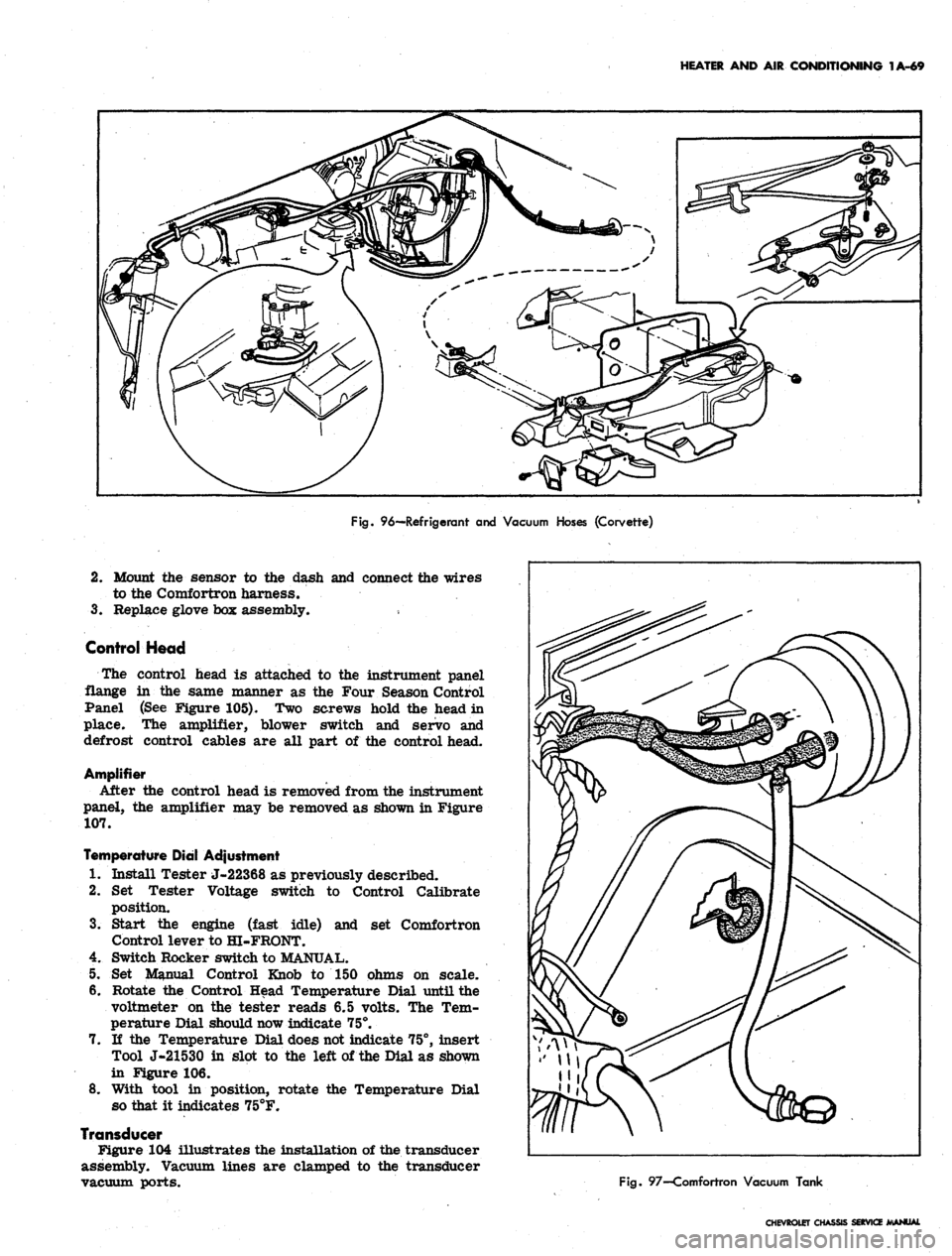
HEATER AND AIR CONDITIONING 1A-69
Fig.
96—Refrigerant and Vacuum Hoses (Corvette)
2.
Mount the sensor to the dash and connect the wires
to the Comfortron harness.
3.
Replace glove box assembly.
Control Head
The control head is attached to the instrument panel
flange in the same manner as the Four Season Control
Panel (See Figure 105). Two screws hold the head in
place. The amplifier, blower switch and servo and
defrost control cables are all part of the control head.
Amplifier
After the control head is removed from the instrument
panel, the amplifier may be removed as shown in Figure
107.
Temperature Dial Adjustment
1.
Install Tester J-22368 as previously described.
2.
Set Tester Voltage switch to Control Calibrate
position.
3.
Start the engine (fast idle) and set Comfortron
Control lever to HI-FRONT.
4.
Switch Rocker switch to MANUAL.
5. Set Manual Control Knob to 150 ohms on scale.
6. Rotate the Control Head Temperature Dial until the
voltmeter on the tester reads 6.5 volts. The Tem-
perature Dial should now indicate 75°.
7. If the Temperature Dial does not indicate 75°, insert
Tool J-21530 in slot to the left of the Dial as shown
in Figure 106.
8. With tool in position, rotate the Temperature Dial
so that it indicates 75°F.
Transducer
Figure 104 illustrates the installation of the transducer
assembly. Vacuum lines are clamped to the transducer
vacuum ports.
Fig.
97—Comfortron Vacuum Tank
CHEVROLET CHASSIS SERVICE JWANUAl
Page 93 of 659
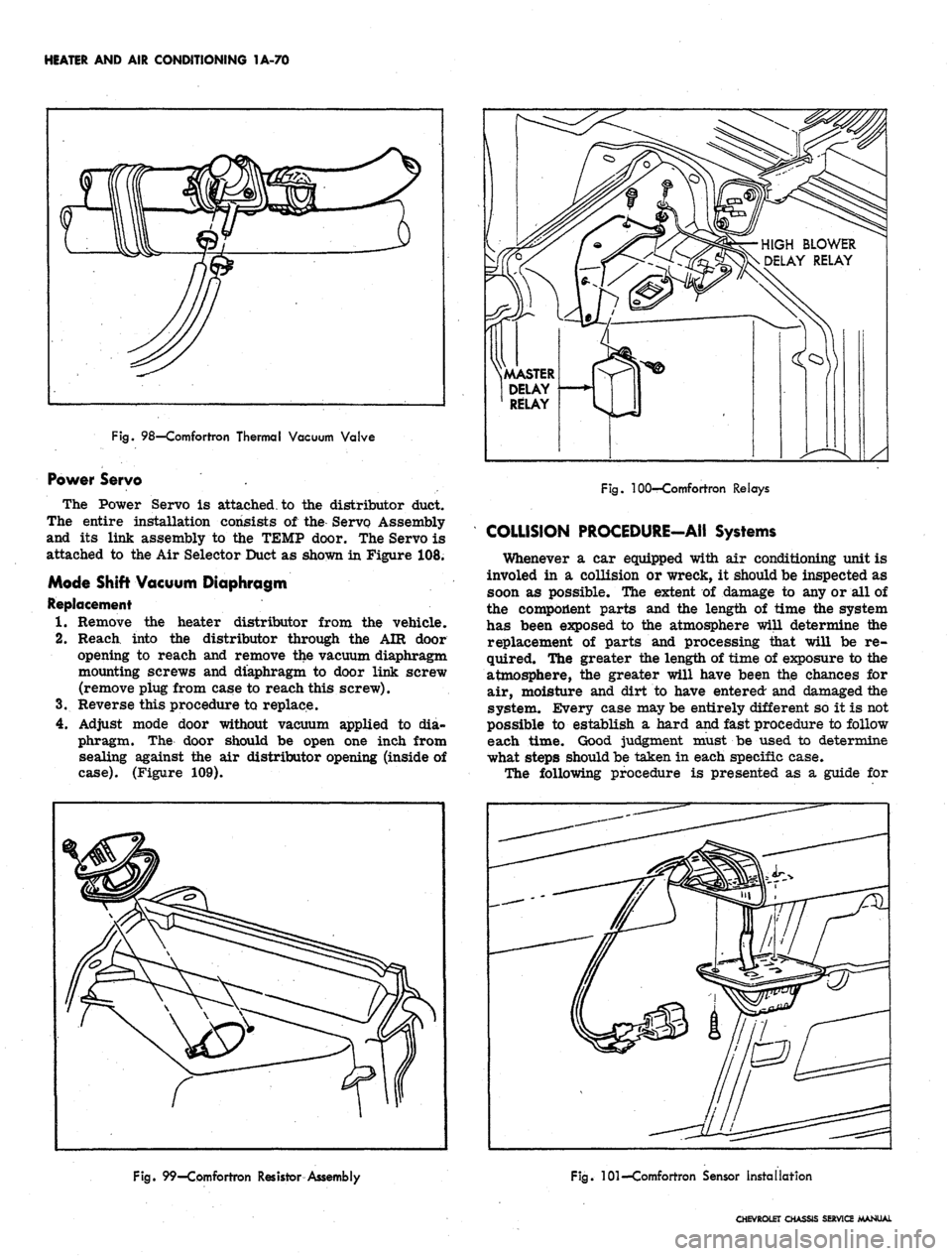
HEATER AND AIR CONDITIONING 1A-70
Fig.
98—Comfortron Thermal Vacuum Valve
Power Servo .
The Power Servo is attached, to the distributor duct.
The entire installation consists of the Servo Assembly
and its link assembly to the TEMP door. The Servo is
attached to the Air Selector Duct as shown in Figure 108.
Mode Shift Vacuum Diaphragm
Replacement
1.
Remove the heater distributor from the vehicle.
2.
Reach into the distributor through the AIR door
opening to reach and remove the vacuum diaphragm
mounting screws and diaphragm to door link screw
(remove piug from case to reach this screw).
3.
Reverse this procedure to replace.
4.
Adjust mode door without vacuum applied to dia-
phragm. The door should be open one inch from
sealing against the air distributor opening (inside of
case).
(Figure 109).
HIGH BLOWER
DELAY RELAY
.MASTER
DELAY
RELAY
Fig.
100—Comfortron Relays
COLLISION PROCEDURE-AII Systems
Whenever a car equipped with air conditioning unit is
involed in a collision or wreck, it should be inspected as
soon as possible. The extent of damage to any or all of
the component parts and the length of time the system
has been exposed to the atmosphere will determine the
replacement of parts and processing that will be re-
quired. The greater the length of time of exposure to the
atmosphere, the greater will have been the chances for
air, moisture and dirt to have entered and damaged the
system. Every case may be entirely different so it is not
possible to establish a hard and fast procedure to follow
each time. Good judgment must be used to determine
what steps should be taken in each specific case.
The following procedure is presented as a guide for
Fig.
99—Comfortron Resistor Assembly
Fig.
101—Comfortron Sensor Installation
CHEVROLET CHASSIS SERVICE MANUAL